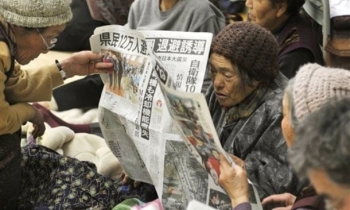Nowhere to be “scene,†women protagonists have less than one-third of all speaking roles in film and are largely absent from powerful positions, according to a United Nations-backed survey released recently. The study argues for the involvement of more female filmmakers in the industry, and for greater sensitivity to gender imbalance on screen.
“The first-ever global study of female characters in popular films reveals deep-seated discrimination and pervasive stereotyping of women and girls by the international film industry,†according to UN Women, which supported the study along with The Rockefeller Foundation. It was commissioned from the Annenberg School for Communication and Journalism at the University of Southern California.
“The fact is – women are seriously under-represented across nearly all sectors of society around the globe, not just on-screen, but for the most part we’re simply not aware of the extent,†said actress Geena Davis, founder of Institute on Gender in Media, which released the study. “In the time it takes to make a movie, we can change what the future looks like,†Davis added noting that media images can have a positive impact on perception.
According to the study, while women represent half of the world’s population, only about 30.9 per cent of all speaking characters are women. Only about 22.5 per cent of the fictional on-screen workforce comprises women, and when they are employed, less than 15 per cent of them are portrayed as business executives, political figures, or science, technology, engineering, and/or math (STEM) employees.
“There are woefully few women CEOs in the world, but there can be lots of them in films,†Davis said. “How do we encourage a lot more girls to pursue science, technology and engineering careers? By casting droves of women in STEM, politics, law and other professions today in movies.â€
The study also showed that women are more likely to be hypersexualised than men, with girls and women twice as likely as boys and men to be shown in sexualized attire, nude, or thin.
Key findings of the study include:
- Only 30.9 per cent of all speaking characters are female.
- A few countries are doing better than the global norm: UK (37.9 per cent), Brazil (37.1 per cent), and South Korea (35.9 percent). However, these percentages fall well below population norms of 50 per cent. Two samples fall behind: US/UK hybrid films (23.6 per cent) and Indian films (24.9 per cent) show female characters in less than one-quarter of all speaking roles.
- Females are missing in action/adventure films. Just 23 per cent of speaking characters in this genre are female.
- Out of a total of 1,452 filmmakers with an identifiable gender, 20.5 per cent were female and 79.5 per cent were male. Females comprised 7 per cent of directors, 19.7 per cent of writers, and 22.7 per cent of producers across the sample.
- Films with a female director or female writer attached had significantly more girls and women on-screen than did those without a female director or writer attached.
- Sexualisation is the standard for female characters globally: girls and women are twice as likely as boys and men to be shown in sexually revealing clothing, partially or fully naked, thin, and five times as likely to be referenced as attractive. Films for younger audiences are less likely to sexualise females than are those films for older audiences.
- Teen females (13-20 years old) are just as likely as young adult females (21-39 years old) to be sexualised.
- Female characters only comprise 22.5 per cent of the global film workforce, whereas male characters form 77.5 per cent.
- Leadership positions pull male; only 13.9 per cent of executives and just 9.5 per cent of high-level politicians were women.
- Across notable professions, male characters outnumbered their female counterparts as attorneys and judges (13 to 1), professors (16 to 1), medical practitioners (5 to 1), and in STEM fields (7 to 1).
“Two decades on, this study is a wake-up call that shows that the global film industry still has a long way to go,†said UN Women Executive Director Phumzile Mlambo-Ngcuka in reference to the Beijing Platform for Action. Adopted in September 1995, the Beijing Platform became the international roadmap for gender equality, which among other factors, called on media to avoid stereotypical and degrading depictions of women.
“With their powerful influence on shaping the perceptions of large audiences, the media are key players for the gender equality agenda. With influence comes responsibility. The industry cannot afford to wait another 20 years to make the right decisions,†Ms. Mlambo-Ngcuka added.
The study analysed popular films across the most profitable countries and territories internationally, including: Australia, Brazil, China, France, Germany, India, Japan, Russia, South Korea, United States, and United Kingdom.










